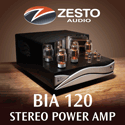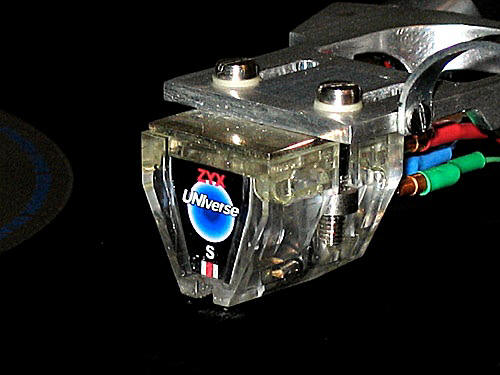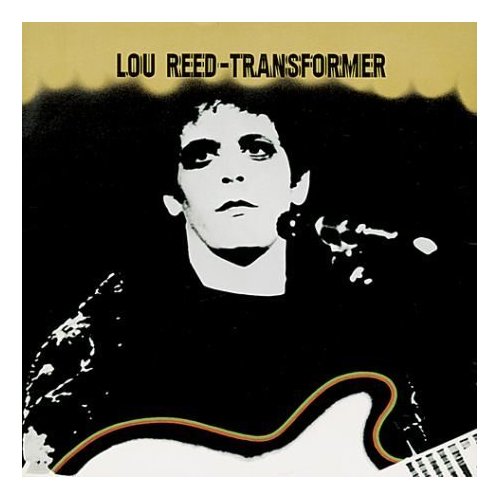|
|
You are reading the older HTML site
Positive Feedback ISSUE 72
zyx Universe II Moving Coil Cartridge - Stuck in an Emotional Groove as reviewed by Myles B. Astor
Very few people could have predicted in 1980 the cornucopia of great sounding cartridges—at literally every price point—available to analog devotees today. A modern day, must-listen to list of cartridges encompasses but is not limited to the likes of Lyra, Clearaudio, Dynavector, Benz, Grado, Air Tight, Koetsu, Ikeda, Transfiguration, Shelter, Sumiko, Allnic, My Eminent, Ortofon, Grado, Miyabi, Miyajime and Soundsmith. Yet few cartridges come close to, much less equal, the ZYX Universe II's ability to make that musical connection with the brain. My first introduction to the latest incarnation of the ZYX Universe cartridge came at the 2013 CES in the LAMM Audio suite. Unlike many other show attendees—and mind you this comes from an absolute dyed-in-the-wool analog lover—I thought that the French Neodio Origine CD player handily outperformed the similarly priced analog front-end comprised of the big Kronos table outfitted with the 12-inch Graham Phantom Supreme II arm and Universe II cartridge. The analog playback system simply sounded dark, sluggish and quite frankly, boring. Perhaps even more puzzling to this analog junkie was why the Origine, particularly in those ever so critical midrange frequencies, shamed the turntable set-up. Well puzzle no longer. The Universe II cartridge used in the LAMM room —and the same sample used for this review—was brand spanking new out of the box. First Impressions Prove Wrong Truth be told, the Universe II is far from a boring cartridge. Indeed, it's that musically engaging quality nee lower distortion that most appropriately defines the Universe II's sound. The Universe II cartridge never draws attention to itself nor screams listen to me, listen to me. No, the music comes first and foremost and sonic attributes second with this transducer. The Universe II is clearly the antithesis of—if there is such a mythical creature—that prototypical "moving coil cartridge sound." Balance wise, the ZYX strikes me as a cartridge ready made for anyone who relishes the Koetsu's musicality but not the cartridge's other downsides (Note: the recently auditioned and hopefully soon to arrive stone bodied Azule Blue may permanently lay to rest that "Koetsu" signature). Indeed, few cartridges on the market can match the Universe II's midrange presence and palpability, tonal palette and most notably, ability to convey musical emotion. In fact, the ZYX's midrange is very reminiscent of that of very good tube triode amplifier. You know and have experienced that feeling at least once in your audiophile journey. That indescribable feeling and ability to reach out and wrap your arms around the images. For instance, take the Hopkins and van Ronk inspired blues cut "Come Back Baby," from that very special Opus 3 recording Eric Bibb April Fools (Opus 3 79-14). There's none of that oh-so-typical "blanket" over the microphone. As a result, the ZYX really extracts more of the deep down emotion and soul in Eric Bibb's voice and allow these qualities to rise to the surface. If the music doesn't for some reason give you goosebumps, then there's either an issue with the cartridge's VTA/SRA setting (especially if the cartridge's VTA/SRA is too low) or somewhere else in the system. While there's no doubt that the Universe II is cut from the same musical cloth as the previously reviewed ZYX Omega Au cartridge (not to mention also the Omega Cu that made its way here after the Au review but was never reviewed), it's also perfectly clear that Nakatsuka's newest offering is far more refined, linear sounding and less colored than its earlier brethren. Overall the biggest sonic difference between the two cartridges—and in retrospect the VPI Classic Direct and 3-D arm combination would have been even more revealing—lies in the in the mid- and upper bass regions. Here the Universe II neatly sidesteps the (though the Cu was a little better than the Gold in this regard) thickening, blurring and exaggeration in the mid- and upper-bass region of the Omega Au. Sam Jones and Neils-Henning Orsted Pedersen basses' on the Double Bass album (Alto/Steeplechase SRCS 1055) have far less overhang although there's still a touch of slowness in this region when compared to cartridges like the Lyra Atlas, Ikeda 9TT or Transfiguration Proteus cartridges. Though exceptionally smooth and seriously low in distortion, the Universe II interestingly never lacks for resolution either. Once again, it's interesting to note that this resolution never comes at the expense of the total package. The Universe II does a splendid job on closely miked recordings such as Masaru Imada Quartet's Now! (Three Blind Mice TBM-2) of rendering the overtones of instruments. One can literally imagine in the "mind's eye" standing near the near piano and hearing the canopy of notes emanating from the instrument. Bells on the "Alter" cut float on an invisible bed of air and are incredibly delicate and light sounding. The lowest levels of reverb decaying and travelling to the back reaches of the stage are wonderfully captured. By contrast, the Lyra Atlas is just slightly colder in presentation but a touch more neutral. No component is perfect and two areas where the Universe II falls slightly short of ultimate is in a slight darkening of the overall picture and a rounding or softening of instrumental transient attack. To be sure, this quality is to a certain extent dependent upon the associated phono cable (see upcoming survey) with the Universe II being slightly more open when combined with something like the Bill Low Signature, Transparent or Graditech and just slightly darker say with either the Kaplan or Audience SE products. Now one album that's stood the test of time and remains to this very day one of my oldest go to reference albums (thanks to Mike at American Audiophile in Lynbrook for turning me onto this album back in the late ‘80s) is the Titanic recording Picaflor: Latin American Music for Guitar and Mandolin (Titanic Mn-5). Now at first blush, a mandolin and guitar recording hardly seems a particularly challenging or revealing test for an audio system. Not so fast cowboy. Picaflor challenges many a component's ability to properly reproduce—especially on highly revealing electrostatic speakers—each instrument's initial transient attack, tone, dynamic accents, speed and low, lower and lowest level details. To be more specific: the guitar shouldn't sound like a mandolin and vice versa (not always a given with some components). Each instrument on this somewhat closely miked recording should possess an immediacy and solidity in space as well as good dose of that of ambience and space surrounding each instrument that analog lovers so cherish. In the case of the Universe II, there's a silky smooth, slightly reverberant and warm sounding guitar with nary a trace of grain; the mandolin possesses its characteristic twang and decay though the instrument's initial transient attack is ever so gently rounded. Where the Universe II really shines, though, is in its ability to retrieve the minutest details such as the musician's fingers on and moving over the strings and the short or long decays of each note and harmonic envelope surrounding each instrument.
"Walk on the Wild Side" (Speakers Corner/RCA LSP-4807) from the superlative Speaker's Corner reissue of Lou Reed's Transformer also serves as a great test for resolution and low frequency tightness. On the plus side, the Universe II possesses a real knack on this track to transport the listener back to the original recording studio. Every word Reed sings draws you further into the song's lyrics ("Walk on the Wild Side" certainly never sounded like this in college and that was with additional help!) and there's no mistaking the judiciously added reverb surrounding his voice. In particular, the Universe II possesses an uncanny ability to portray instruments and singers on the outer edge of the stage especially when the Thunderthighs enter from far the furthest reaches of the back stage and move forward into the sides of this mix. The added ambience surrounding the Thunderthighs completely fills, envelopes and defines the room/stage's boundaries. On the minus side, the Universe II just loses a bit of the differentiation of the song's beat compared to cartridges like the Atlas or Ikeda 9TT. No less impressive—just as with the ZYX Omega Au cartridge—is the Universe II's talent for throwing a wall-to-wall (and even a bit more) soundstage. Kenny Burrell literally sounds like he's playing in the next door apartment on Blue Lights, Vol. II (Classic Records/Blue Note BST 81597). The rest of the Burrell's talented crew—save for the early hard left and right positioning—are solidly positioned across the stage. And just as on the Blue Note tapes, there's simply an amazing sense of three-dimensional, palpable instruments present in the listening room. Most importantly, there's the Universe II's ability to reproduce the unique tonal colors of Burrell's guitar–not to mention those of Barney Kessel, Grant Green, Jim Hall, George Benson and many others. Now the Universe II can't match the transient attack of say the Atlas or Ikeda 9TT cartridges, but the Universe II puts it into a more relaxed, absolutely effortless and unstrained package. The Universe II does add a little bit of its own flavor to this recording than the Atlas but then again, this cartridge is far less euphonic sounding than the previously reviewed ZYX Omega Au version. Equally impressive is the Universe II's ability to recapture and recreate the recording's sense of ambient space. Take for example the last movement, "Allegro marciale-Presto," from one of my favorite Mercury recordings, Paul Fetler's Contrasts for Orchestra (SR 90282). The Universe II gives us a real taste of what Robert Fine heard when he committed this music to tape. There's an amazing sense of see through transparency from the front to the rear of the Northrup Hall's stage in Minneapolis. There's an ability to hear the brass echo off the back and side walls of the hall. The biggest area where the Universe 2 falls somewhat short of ultimate on the Fetler piece is in the lower reaches of the audio spectrum. Here the Universe 2 loses a little of the drum's sense of urgency, tightness and dynamics. Again these shortcomings can be addressed to some extent with careful selection of phono cables. Let's not forget to mention before leaving the amazing, rosiny sound of the string section. String solos really stand out for the midrange ease and realism. Neither does the Universe II smooth out the sound of the string section since that characteristic Mercury "string sound" is still present but not overwhelming. Nor is the bite of the strings overemphasized as with other cartridges. Once again, proper phono cable selection will avoid that edgy string sound syndrome as well as optimizing the cartridge's dynamics. Making A Permanent Connection New or broken-in, the Universe II won't bowl you over at first listen (not unlike many good products!). Maybe not even with a second or third listen. But the more one listens to the Universe II, the more one falls in love in love with Universe II's honesty and faithfulness to the music. Couple that honesty with the Universe II's quietness, resolution, transparency, tonal presentation and lifelike qualities and can you say winner? Sadly, this cartridge came in before the arrival (unfortunately delayed but that's usually how things happen in the industry) of the new and far more neutral and revelatory VPI Classic Direct and 3-D arm and Silent Running Ohio Class XL+2 base. As good as the old table was, this new front-end would have unquestionably improved the cartridge's strengths and reduced it issues. Perhaps the greatest mark of an exceptional product is the length of the withdrawal symptoms when the unit is returned to the distributor; in the case of the Universe II, the Jonesing still hasn't gone away. Technical Highlights ZYX, as previously reported in my original Omega Au review, was founded by Hisayoshi Nakatsuka nearly 30 years ago. Nakatsuka's long and storied high-end audio resume includes having first worked on the Kenwood Trio components before then moving onto Ortofon. After leaving Ortofon, Nakatsuka moved to Namiki Precision Jewel where he among other projects, developed the now famous Monster Cable cartridge line. No doubt many readers, as was I, are curious about the differences between Nakatsuka's latest Universe II and the original production version. Despite my best efforts, however, there wasn't a lot of technical information to be gleaned about the new Universe II cartridge. It appears that Nakatsuka is playing it very close to the chest with his latest creation and what information was available, wasn't necessarily new. The Universe II is, as are all ZYX cartridges, "equipped with the original real sound power generation system where time-is distortion is cancelled by the use of several patented technologies. The Real Stereo addresses 15 factors in cartridge design including but not limited to magnetic pole direction, coil winding direction and method, grounding techniques and attention to dynamically induced currents." Nakatsuka's cartridges (and other products) are once again being handled in North America by SoraSound in North America. Setting up and aligning the Universe II in the VPI Classic 10.5i arm was more difficult than say the Atlas with its easily viewable cantilever but worlds easier than say the Ikeda 9TT or Transfiguration Proteus cartridges where something like the Hubble telescope proves handy (see upcoming reviews). The Universe II performed its best in the VPI Classic 10.5 arm tracking between 2.0 and 2.05 gms. Cartridge loading seemed best between 100 and 180 ohms into Doshi phono stage; so both 100 and 180 were used during the review. Finally, while the Universe II's 0.24 mV output places it squarely on the low side of moving coil cartridges, its perceived output—and the Benz's also come to mind—belies its relatively low output. In other words, the Universe II sounds much bigger than its nominal rating. No matter, one definitely benefits from using a quiet phono section to amplify the Universe II. Myles B. Astor
ZYX Universe II Cartridge Output: 0.24 mV
|










